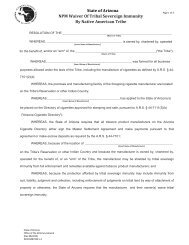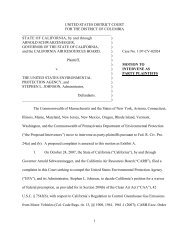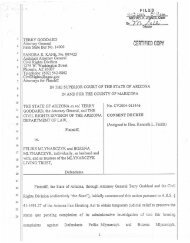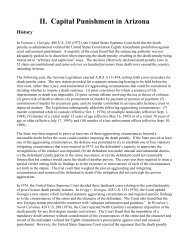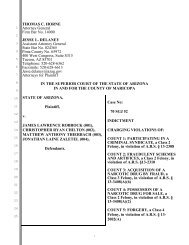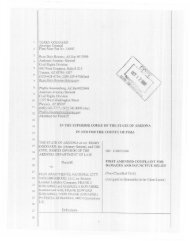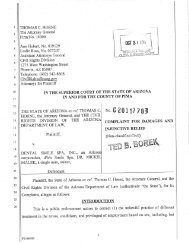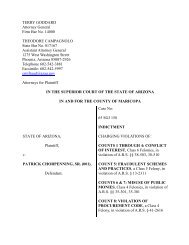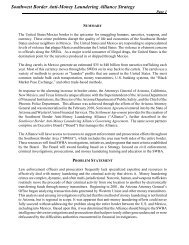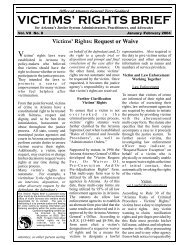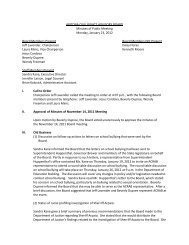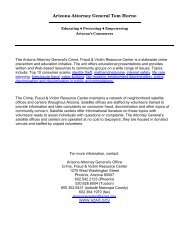2010 Arizona Youth Survey - Arizona Attorney General
2010 Arizona Youth Survey - Arizona Attorney General
2010 Arizona Youth Survey - Arizona Attorney General
Create successful ePaper yourself
Turn your PDF publications into a flip-book with our unique Google optimized e-Paper software.
How Charts to Read and the Tables Charts in in this Report (cont’d)<br />
Gambling<br />
Gambling behavior charts show the percentage of<br />
students who engaged in each of the 10 types of<br />
gambling “for money, possessions, or anything of value”<br />
during the past year: played gambling machines,<br />
played the lottery, bet on sports, played cards, bought<br />
a raffle ticket, played bingo, gambled on the Internet,<br />
bet on a dice game, bet on a game of personal skill and<br />
bet on horse or other animal races. The chart also<br />
shows the percentage of students who engaged in any<br />
gambling behavior during the past year.<br />
Risk and Protective Factor Profiles<br />
Risk and protective factor scales measure specific<br />
aspects of a youth’s life experience that predict whether<br />
he/she will engage in problem behaviors. The scales,<br />
defined in Table 3, are grouped into four domains:<br />
community, family, school, and peer/individual. The<br />
risk and protective factor charts show the percentage of<br />
students at risk and with protection for each of the scales.<br />
Where <strong>Youth</strong> Obtained Alcohol<br />
This chart displays data regarding the ways that<br />
students obtained alcohol in the past 30 days. The data<br />
focus on a subgroup of students who indicated at least<br />
one means of obtaining alcohol. (Students reporting no<br />
alcohol use are not represented.) It is important to note<br />
that the charts represent a subgroup of users and not<br />
the entire survey population. Additionally, the smaller<br />
the sample, the more dramatic the influence of a<br />
student's responses. For example, if only one student in a<br />
particular grade reported where he/she obtained alcohol,<br />
each category would show up as either 0% or 100%.<br />
The chart legend indicates the sample size for each<br />
grade surveyed to help clarify the value of the data.<br />
School Safety<br />
The school safety profile charts contain the<br />
percentages of students who felt unsafe at school or on<br />
the way to school, were threatened or injured with a<br />
weapon at school, were in a physical fight at school,<br />
carried a weapon to school or were picked on or<br />
bullied at school. The complete questions and values<br />
for each response option can be seen in Table 12.<br />
Additional Data in this Report<br />
In addition to data presented in the charts and Tables 4<br />
through 12, Tables 13 through 15 contain information<br />
useful for prevention planning.<br />
Table 13 contains the information that is required by<br />
communities with Drug Free Communities Grants,<br />
such as the perception of the risk of ATOD use,<br />
perception of parent and peer disapproval of ATOD<br />
use, past 30-day use, and average age of first use.<br />
Tables 14 and 15 contain questions new to the <strong>2010</strong> AYS<br />
on subjects of interest to prevention providers.<br />
The Community Data Project<br />
Supported by a grant from the <strong>Arizona</strong> Governor's Office<br />
for Children, <strong>Youth</strong> and Families, the Community<br />
Data Project is a multi-agency effort to create a central<br />
repository for <strong>Arizona</strong>'s substance abuse and crime<br />
data. Through a user-friendly web site, individuals will<br />
have a one-stop portal where they can select the type<br />
of data they need, specific demographic characteristics,<br />
and their geographic level of interest. Various output<br />
options will be offered, including data tables, graphs,<br />
and maps to cover a variety of reporting and<br />
visualization needs. The web site will be a useful tool<br />
for practitioners and policymakers who are addressing<br />
substance abuse, juvenile delinquency, and crime and<br />
the criminal justice system by providing them with a<br />
comprehensive picture of the characteristics and needs<br />
of <strong>Arizona</strong>’s communities. Having data that are specific<br />
to the users geographic area of interest will not only<br />
lead to an enhanced understanding of the community<br />
issues related to drugs and crime, but it will also<br />
maximize data-for-decision-making capabilities for<br />
things such as the appropriate program content,<br />
identification of at-risk target areas and populations,<br />
grant writing and reporting, monitoring progress of<br />
prevention and intervention initiatives over time, and<br />
determining resource allocation. Currently, the web<br />
site is under construction, but we anticipate it will be<br />
ready by end of summer <strong>2010</strong>. Please visit us then at:<br />
www.azcjc.gov/ACJC.Web/sac/CommunDataPrj.aspx<br />
8



